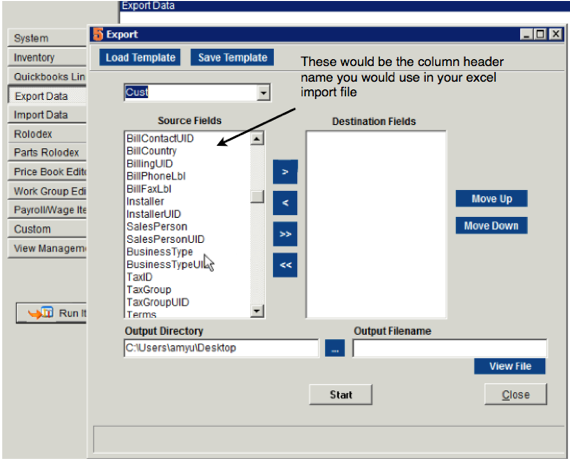Importing Customers
When importing customers, you will be importing into both the Cust (Customer) table and the CustCont (Customer Contact) table. You will need the following:
Spreadsheet with your billable customer
Spreadsheet with your site customers (If you are using parent/ child structure)
To review parent child structure, please click Customers
Spreadsheet for your contacts and what customer they are associated with
First you will import your billable customer (parent)
Then you can import the site customers and link them to the parents
**Make sure each customer record you import is a unique name. QuickBooks does not allow you to have the same name twice.**
Step 1: Prepare the Billable Customer import:
1. Open Excel and create columns for the site and billing tab based off image 1 below.
2. Paste the customer name in the Name and BillName column, as well as the address info.
3. In the IsBillable column, enter TRUE for each row
4. If the customer needs to sync to QuickBooks, create a column for QBExport and enter TRUE in each row.
5. Enter a column for IsActive and enter TRUE in each row
6. If there are other fields you want to import into such as Terms, TaxGroup, Business Type, you will need to export the tables to get the UID as described above.
To see all the column header names in the table you are importing into:
- Go to Utilities > Utilities > Export Data and click Run it
- In the Export window that open, select the Cust table in the drop down
- The Source Fields column show you all the column header names you would use in your Excel spreadsheet
Step 2: Import the Billing Customers
It is a good idea when importing, import first a small sample of your whole spreadsheet including the column headers. Check your import before importing the whole spreadsheet. (for example, copy row 1,2 & 3 into another spreadsheet and call it Test Import. Import that first, check your import, and if all is fine import the full spreadsheet, but remember to take out the records you imported off the full spreadsheet - the customers that were in row 2 & 3)
1. Go to Utilities > Utilities > Import Data and click Run It. The Data Import window opens
2. In the Source Filename field, browse for your import file. (when browsing for your file, make sure you are search “All Files”)
3. In the Destination table drop down, select Cust
4. You will see a preview of your spreadsheet in the grid
5. Click start.
6. You will be asked if you want to backup your data. You should be regularly backing up your data, so usually people click No to skip the backup.
7. When the import is complete you can close the Data Import window and look in the Customer module for the billing customers you imported.



